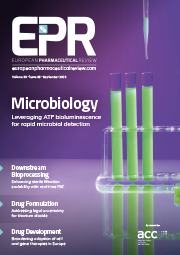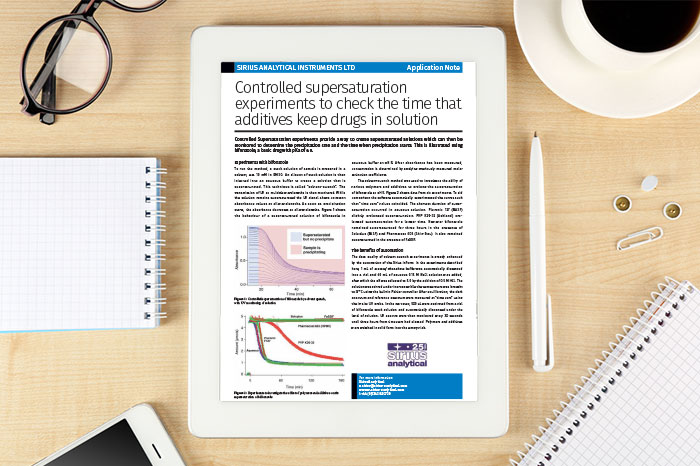App Note: Controlled supersaturation experiments to check the time that additives keep drugs in solution
Posted: 8 January 2015 | Sirius Analytical Instruments Ltd
Controlled Supersaturation experiments provide a way to create supersaturated solutions which can then be monitored to determine the precipitation rate and the time when precipitation starts. This is illustrated using bifonazole, a basic drug with pKa of 6.0.
Experiments with bifonazole
To run the method, a stock solution of sample is prepared in a solvent, e.g. 10 mM in DMSO. An aliquot of stock solution is then injected into an aqueous buffer to create a solution that is supersaturated. This technique is called “solvent-quench”. The transmission of UV at multiple wavelengths is then monitored. While the solution remains supersaturated the UV signal shows constant absorbance values at all wavelengths. As soon as precipitation starts, the absorbance decreases at all wavelengths. Figure 1 shows the behaviour of a supersaturated solution of bifonazole in aqueous buffer at pH 5. After absorbance has been measured, concentration is determined by applying previously-measured molar extinction coefficients…
This application note is restricted - login or subscribe free to access


Why subscribe? Join our growing community of thousands of industry professionals and gain access to:
- bi-monthly issues in print and/or digital format
- case studies, whitepapers, webinars and industry-leading content
- breaking news and features
- our extensive online archive of thousands of articles and years of past issues
- ...And it's all free!
Click here to Subscribe today Login here
Related content from this organisation
- Paul Whittles takes the reins at Sirius Analytical!
- Sirius inForm to be used by leading research group at Purdue University
- Sirius unveils Sirius Scissor – the first in vitro model for the subcutaneous injection of biopharmaceuticals
- App Note: Controlled supersaturation experiments to check the time that additives keep drugs in solution
- New instrument for automated biorelevant biphasic dissolution and solubility testing





